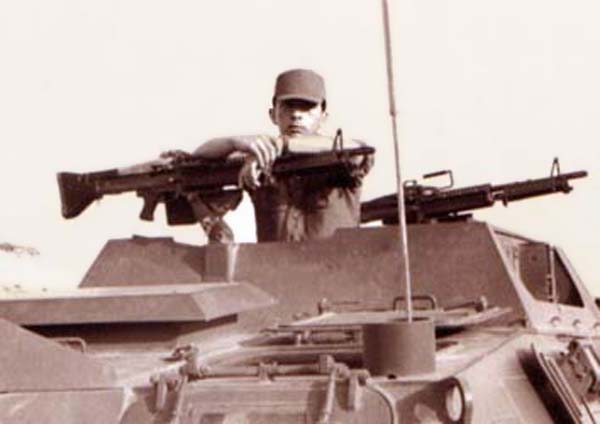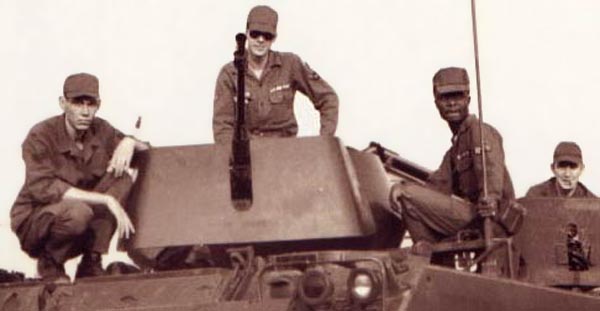Vietnam
Biên Hòa AB
Heavy Weapons, Page 1
Air Police / Security Police Squadrons
34th ABG Air Police Squadron, Assigned Biên Hòa AB, c.1964-1965
3rd Security Police Squadron, Assigned Biên Hòa AB, 8 Nov 1965-15 Mar 1971
6251st SPS Assigned Biên Hòa AB, 8 Jul 1965
(attached to 3d TFW, 21 Nov 1965–8 Mar 1966)
c. 1972, until Biên Hòa closed in 1972 or early 73
© 2009, by VSPA
|
| |
|
|
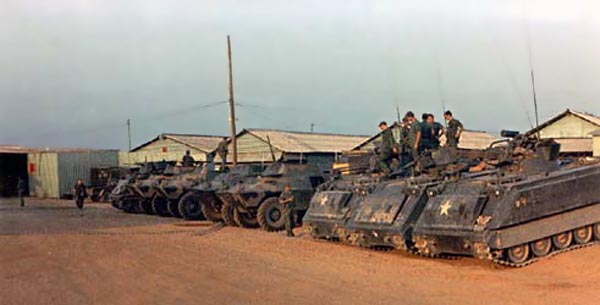
1. Biên Hòa AB, Security Police V100s (left), and US Army APC (right). Photo by Ernest Govea. 1966-1967.
I took the picture of the Army APCs and the ‘Vulcan Combat Team’ (under the OpCon of the 5/2d ADA) in February of 1969.
Elements of the 11th Armored Cav. were
brought onto Biên Hòa Air Base to support the 3rd SPS prior to the big offensive that the NVA/VC launched on
February 23rd, 1969. There was also one 11th Armored Cav. tank, an M48, but I never got any pictures of it.
I do not want to project the impression that the Vulcan gun is an SP Vulcan, as that would be incorrect. It is an Army ‘Vulcan Combat Team’ under the OpCon of the 5/2d ADA. In the close up photo of the Vulcan with the troops you see in the background, those troops, as well as those standing on the APCs, are
11th Armored Cav. troops, with a few USAF SPs in cammies.
Ernest Govea
In support of units like the 11th Cav, was the M163 Vulcan 20-mm Gatling gun. The Army’s experimental ‘Vulcan Combat Team’ under the OpCon of the 5/2d ADA, was extended an additional 3-months service in response to the Tet attacks around Saigon. In the close up photo of the Vulcans with the troops you see in the background, those troops, as well as those standing on the APCs, are Vulcan crewmen with a few USAF SPs in cammies. SSG Vincent DeSantis commanded VCT #4 seen in the foreground. Paul Kopsick,
NDQSA Historian, www.ndqsa.com
|
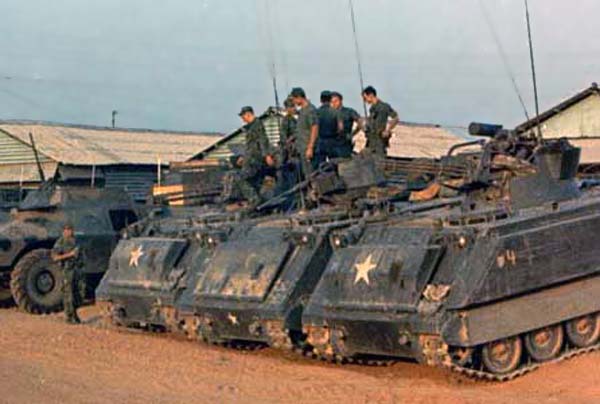 2. Biên Hòa AB, US Army11th Armored Cav M113 APC Close Up. Photo by Ernest Govea 2. Biên Hòa AB, US Army11th Armored Cav M113 APC Close Up. Photo by Ernest Govea. 1966-1967. |
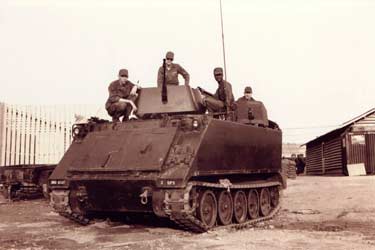
3. Biên Hòa AB, SP M113 APC Close Up, with .50cal. Photo by Ernest Govea. 1966-1967. On the night of February 23rd we were hit hard at Biên Hòa with rockets and mortars. I was the driver on what was then the only Air Force APC M113 (Fluffy was her name) and we were parked out near the east perimeter. Our mission was to respond to any hot spot with lots of firepower. The whole base was lit up from exploding rockets and mortars and one of them hit the pilot's oxygen tanks causing multiple explosions. I know because I called it in and Defense Control informed us it was the pilot's oxygen tanks.
|
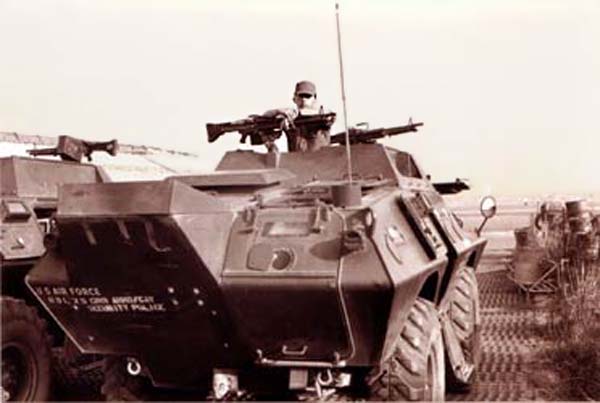 4a. Biên Hòa AB, USAF SP V100. M60. 4a. Biên Hòa AB, USAF SP V100. M60. Photo by Ernest Govea. 1966-1967. The guy in the V-100 with his arms resting on an M60 is me at 19 years of age. |
|
|
|
4b. Biên Hòa AB, USAF SP V100. M60 Close Up. I have been meaning to write a story about the night of Feb. 23rd but have not
gotten around to it. The guy in the V-100
with his arms resting on an
M60 is me at 19 years of age.
|
5. Biên Hòa AB, USAF SP V100. .50cal. Close Up. The four SPs on Fluffy are, from left to right, an NCO whose name I have forgotten; Ustonovich, Sgt Dicks, our track commander and a very bright NCO, and A1C Gelderman from Pennsylvania.
|
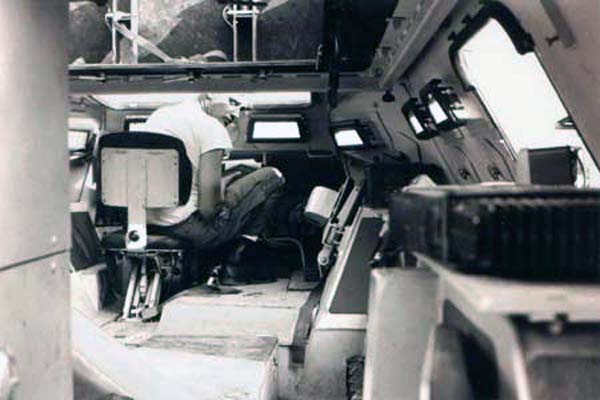 6. Biên Hòa AB, Interior of V100. 6. Biên Hòa AB, Interior of V100. Photo by Ernest Govea. 1966-1967. |
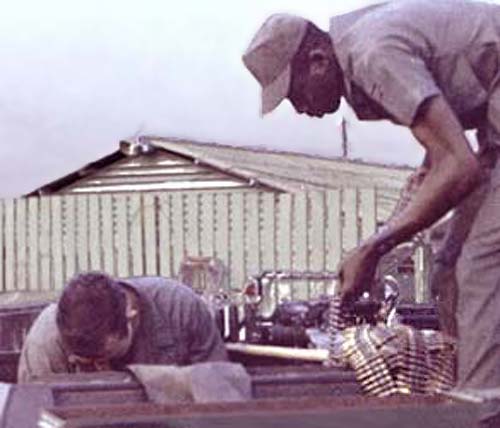
7. Biên Hòa Air Base: Loading ammo. V100. The 3rd SPS at the time had several V-100s some armed with miniguns as seen in the picture of the SP bent over in the "commando car" and the black SP with the belt of M60 ammo in his hands. It's a bad picture but you can still see the mini gun on his right and the two SPs are preparing it for night duty.
Woe to Charlie if they came across this team.
I and several other SPs were trained and qualified as mini gun men but that's another story. Ernest Govea
The Air Force in 'Nam also had miniguns.* We had them at Phan Rang Air Base and Phu Cat Air Base [Ubon RTAFB, and others]. Our units came from aircraft and were adapted for our use. Guys in the Field Maintenance Sq Fabrication Shop built mounts for various weapons systems, so we could use them in a mounted mode where needed. One of the problems we had in Vietnam was that our equipment authorizations in Table of Allowance 538 didn't "authorize" the right firepower to protect the bases. Everything was based on a CONUS based SAC defensive mentality. Most of our heavy weapons were scrounged and unauthorized. Fortunately, the Army was very benevolent in providing us with firepower and training, to allow us to do the job. Gary Jones
There is no question that our commando cars had miniguns and I was trained as one. A couple dozen of us were taken out to fire the minigun and when it was my turn I leaned back hanging on the butterfly grips. I turned the barrels so they were aimed at the 55 gal. drum to my far left and pushed the button. As I turned the barrels to my right. You could see dust flying up from behind all the 55 gal. drums. Most guys fired bullets everywhere but at the drums. An NCO standing next to me slapped me on the back and said "You're a minigun man!" I believe there was an error made, however, as I was never assigned to man a minigun. I was on several occasions assigned to carry a 90 mil. recoilless rifle and six rounds of ammo, three "beehive" (anti-personnel), and three HE (high-explosive). They came in wooden crates and I would take one at a time out to a commando car throw them in the back then go get the 90 mil. and hop in. Funny thing is that I was trained on the 90 mil but never fired it. Most of us did not fire it. Too expensive I suppose. Ernest Govea
|
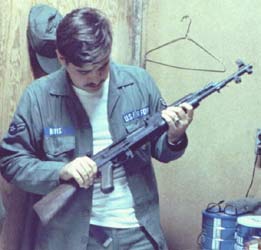 8. Biên Hòa Air Base: Checking out weapon. 8. Biên Hòa Air Base: Checking out weapon.
|
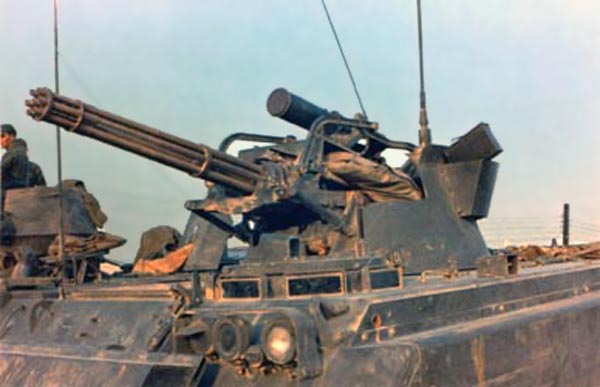
9. Biên Hòa AB, US Army M163 VADS 20-mm Gatling Gun (Vulcan), part of the Vulcan Combat Team. Photo by Ernest Govea.
The M -163 Vulcan guns were brought in-country to test them as possible replacements for the M-42 Dusters and M55 Quad-50’s. They were supposed to be there only 6-months but were extended to 9-months because of Tet. The commander of the evaluation team (CPT John Wilson) was killed in a rocket attack because the bunker they were in was full and several men gave up their position inside the bunker to locals and were forced to stay unprotected near the opening. His XO, LT Robert Martinez, lost a leg in the same explosion. The Vulcans were instrumental in many missions around TSN. LT Harold Fritz (Troop A, 11th Cav) was awarded the MOH during one fire fight where credited the lone Vulcan in the group with saving the convoy ambushed on QL13 near Quan Loi on 11jan69. We are also interested in seeing how others units and branches used the M55 Quad-50 mount. The Army had four Quad 50 AWSP batteries ( D-71, E-41, G-55, & G-65), that served from the delta to the DMZ from 1967-1972.” Thanks again. Paul Kopsick,
NDQSA Historian, www.ndqsa.com
|
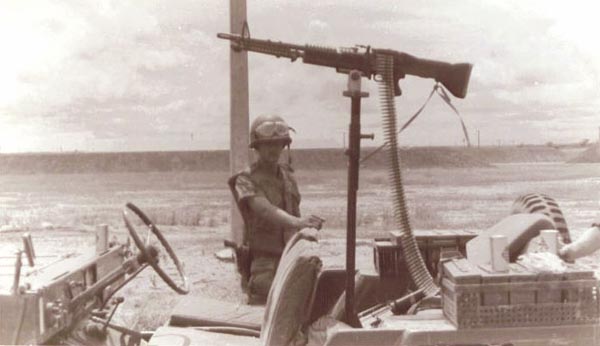 10. Biên Hòa AB. SP QRT jeep, Airman John Beam with M60. Photo by Vinson 10. Biên Hòa AB. SP QRT jeep, Airman John Beam with M60. Photo by Vinson (?). |
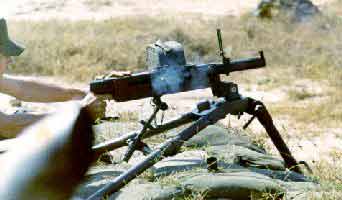
11. Biên Hòa AB. Range firing of 40mm grenades. Photo by Raymond G. Morgan. 1971-1972.
|
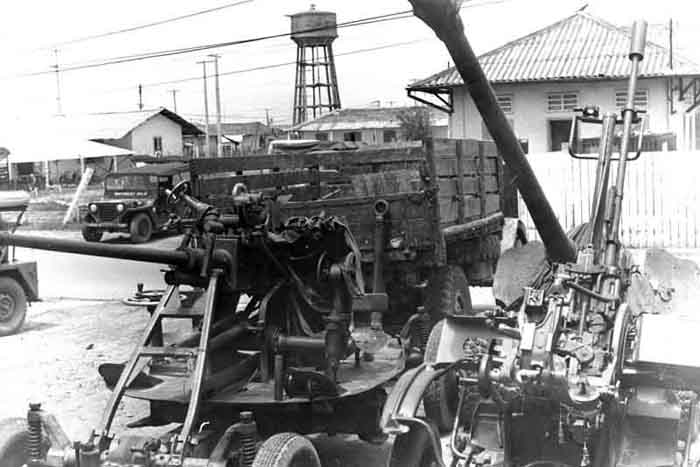 12. Biên Hòa AB. Captured AAA from the Biên Hòa area. Stored rear of CSC. 1965. 12. Biên Hòa AB. Captured AAA from the Biên Hòa area. Stored rear of CSC. 1965.
Photo by Phil Block, LM 203, BH, 3rd SPS; TSN, 377th SPS, 1965-1968. |
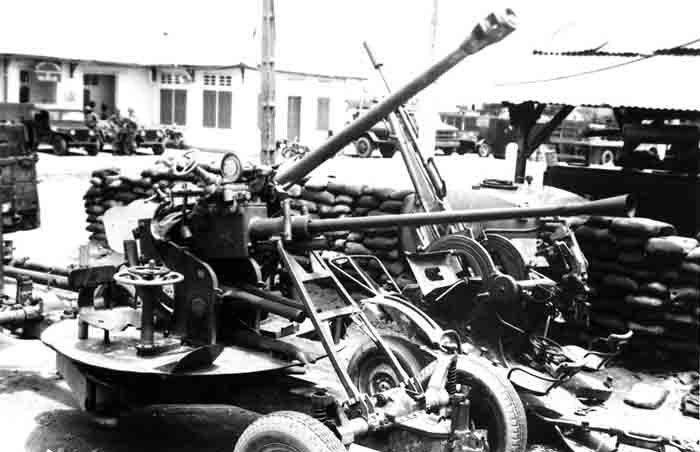 13. Biên Hòa AB. Captured AAA from the Biên Hòa area. Stored rear of CSC. 1965. 13. Biên Hòa AB. Captured AAA from the Biên Hòa area. Stored rear of CSC. 1965.
Photo by Phil Block, LM 203, BH, 3rd SPS; TSN, 377th SPS, 1965-1968. |
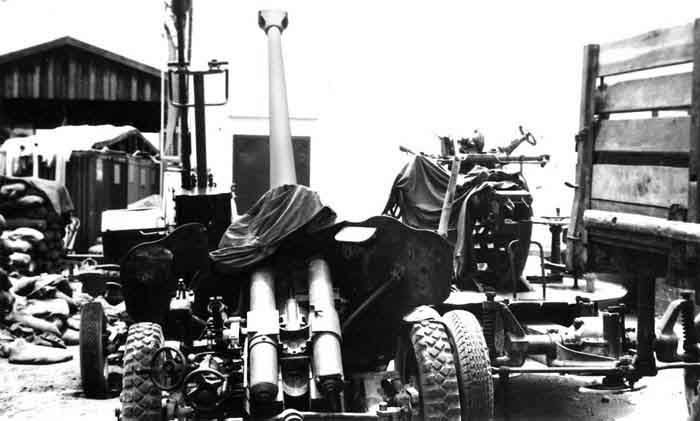 14. Biên Hòa AB. Captured AAA from the Biên Hòa area. Stored rear of CSC. 1965. 14. Biên Hòa AB. Captured AAA from the Biên Hòa area. Stored rear of CSC. 1965.
Photo by Phil Block, LM 203, BH, 3rd SPS; TSN, 377th SPS, 1965-1968. |
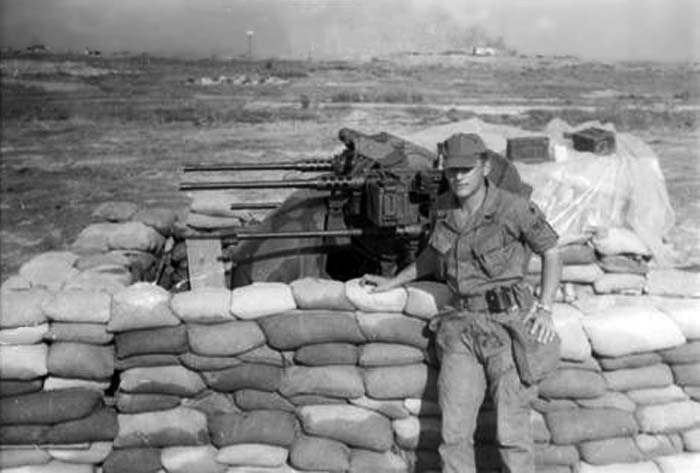
15. Biên Hòa AB. William Gallant at Vietnamese Perimeter Bunker, with Quad-50s. 1968.
Photo by William Gallant, LM 246, BH, 3rd SPS, 1966-1967.
There was definitely a quad fifty in Abel area of Biên Hòa, i.e. the north west perimeter, but my recollection was that it was manned by Vietnamese troops. What I don't know is whether the one in the photograph is the one I knew about. I tend to remember it as being on the side of a hill and the one in the photo appears to be on flat land but I cannot be sure. I remember other SPs talking about how they had gotten into the seat and how you could move the quad and point the barrels up, down and left and right but I don't remember what powered it.
[At] Biên Hòa there was a small number of bunkers manned by Vietnamese Air Force troops on the perimeter. In a few (very few) instances there were both SPs and Vietnamese troops together. I remember that because in Bravo area one night my good buddy John Fisher from Uniontown, Pennsylvania, and I were pared up with one, maybe two Vietnamese troops. I remember because John was telling the Vietnamese troops that Major Tai was coming. Major Tai, the Vietnamese base commander, was dreaded because he was known to shoot troops on the spot who didn't live up to his standards, and John was just trying to instill fear in the guy.
Anyway, there was definitely a quad fifty at Biên Hòa and I remember seeing it off in the distance but I am certain it was Vietnamese and not SP or US Army. In fact I can tell you that there was only one bunker that was manned by the Army and it was on the southeast side of the base facing the town of Biên Hòa. It was manned by members of the 145 Aviation Battalion, a helicopter assault group. It has been a while since I read their version of the "Battle of Biên Hòa" https://www.145thcab.com/History/NL09HIST.htm but last time I read it they give absolutely no credit to SPs. Ernest Govea
----------------
* Don Poss: During research, I reread the below referenced “Air Base Defense In The Republic of Vietnam 1961-1973
” which documents USAF Security Police use of quad 50-cal machineguns and also miniguns. I thought you might find the article interesting. The below link takes you to the book, posted at VSPA.com, where you may read the complete referenced page 95. To save time, I include part of the article below:
Air Base Defense In The Republic of Vietnam 1961-1973
, pg-95:, by Roger J. Fox (Ret. LTC) [RIP].
“The 1968 Tet Offensive drove home the need for heavier security police weaponry. Thus the Air Base defense arsenal acquired the M-67 90-mm recoilless rifle, the M-29 81-mm mortar, the M-72 66-mm high-explosive antitank (HEAT) rocket, and the M-2s 50-caliber heavy-barrel machinegun. This ordnance helped the security police to deal with VC/NVA forces fighting from prepared/overrun positions or from armored vehicles. The chance to do so did not come however, and the new weapons joined the rocket launchers in H&I fire. The M-2 machineguns and M-29 mortar also took part in combat operations, the mortar being widely used for illumination. On the other hand, there is no documented combat employment of the recoilless rifle or the HEAT rocket after Tet 1968.
“Another class of weapons consisted of those informally secured or locally made by the security police at certain bases. At Tan Son Nhut two gun units were thus obtained, each made up of four M55 .50-caliber machinegunsand a M-45C armored mount. With these units bolted to their beds [in] two 2 1/2-ton trucks parked every night in revetted positions at either end of the main runway.
“At Biên Hòa, Phan Rang, and Phu Cat, security police came by several GAU-2BI A 7.62-mm miniguns (the kind of fast-firing machineguns found in AC-47 and AC-119 gunships). Mounted on jeeps or XM-706 armored cars, the miniguns supplied H&I fire and served as mobile weapons for reaction force.
“At Biên Hòa-where there was a special talent for this sort of thing security police came up with an explosive-incendiary-illumination device and nicknamed it Fire Drum. A modified mixture of phougas [A mix of napalm and white phosphorous]." Fire Drum consisted of a metal napalm-filled container, like that used for shipping 175-mm propellant charges. The drum was buried in the ground at an angle, with the protruding open-end covered by a weatherproof plastic membrane and pointing toward the base perimeter. Upon command, an electric circuit touched off the explosive charge under a plunger at the bottom of the container-instantly expelling the napalm that was at once ignited by a white-phosphorous grenade. Range and lateral dispersal hinged on the size and angle of the container and the amount of napalm. The two sizes of Fire Drum at Biên Hòa thrust burning napalm as far as 61 to 122 meters with sideward coverage of 61 to 30 meters. If steel fragments were wanted in the burning napalm, a claymore antipersonnel mine replaced the explosive charge.”
|
|
|

Click to Report BROKEN LINKS or Photos, or COMMENT
|
|
|
© 1995-2023, Vietnam Security Police Association, Inc. (USAF). All Rights Reserved.
|



